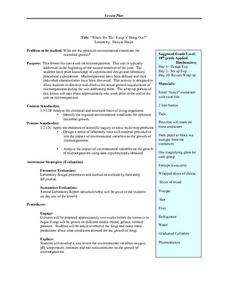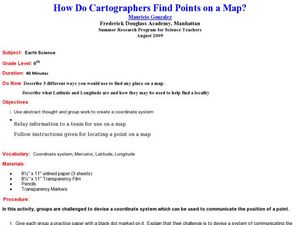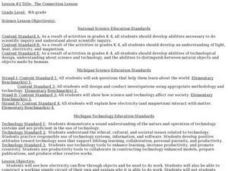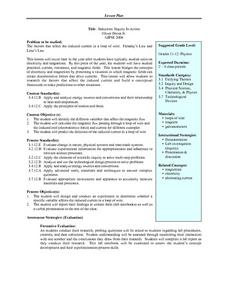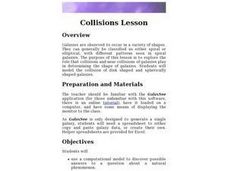Curated OER
Getting to Know Soil
Students make predictions and analyze soil. In this soil properties lesson, students make predictions about soil properties for various soil samples. Students examine the types of soils and record their observations. Students analyze...
Curated OER
Magnify That
Students observe many different objects using a magnifying lens. In this magnification lesson plan, students learn that scientists use different tools, and they use the tool to magnify objects in the classroom to see objects in better...
Curated OER
"Where Do The 'Fungi's' Hang Out?"
Tenth graders engage in a lesson looking for the ideal conditions for microbial growth. The lesson is to be given once they have background knowledge about microbes. Students set up a lab in order to grow cultures over a period of two...
Curated OER
Jr. Chef Club
Students review proper hand washing techniques and make a recipe. In this cooking lesson plan, students explore how to wash their hands properly before cooking and how to make a few edible treats.
Alabama Learning Exchange
What Color Are The Leaves?
Young scholars identify the colors in leaves. In this chromatography lesson, students read the book Why Do Leaves Change Color? and construct chromatography strips to identify the colors of leaves.
Curated OER
Different Types Of Bugs
First graders create their own bug that contain the different characteristics that a bug can have. In this bugs lesson plan, 1st graders first list 3 - 5 characteristics before they create their bug.
Curated OER
Physical Differences
Students read the book We Can Do It! and discuss how we are all physically different. In this physically different lesson plan, students read the book, discuss their differences, and participate in a smelling and touching activity to see...
Curated OER
And the Bacteria Ran Away with the Petri Dish
Sixth graders complete a think, pair, share activity on an antibiotic overhead. In groups, they participate in an exercise in which they can see how germs behave and how they are treated. To end the lesson, they discuss how a...
Curated OER
Don't Forget the Three R's
Students encourage one another in recycling. In this environment and art lesson, students create a new recycling bin that would help people in remembering to recycle.
Curated OER
How Do Cartographers Find Points on a Map?
Ninth graders describe latitude and longitude and how they may be useful to find things on a map. In this cartography lesson students divide into groups and devise a coordinate system that can be used to communicate a position.
Curated OER
Fling It
Students investigate the best design using technology. In this science instructional activity, students construct a freestanding object with specific materials to be able to shoot a ping pong ball and a marshmallow. They have to adjust...
Curated OER
Pendulum Clocks
Students use string, wire, weights, and a stopwatch to build pendulum clocks. In this pendulum clocks lesson plan, students use the pendulum clocks to investigate weather, climate, force, and motion.
Curated OER
Alka-Seltzer Rockets: How to Build Your Own Rocket
Students create a rocket using Alka-seltzer of baking soda and vinegar. In this physics lesson, students identify the factors affecting the length of time the rocket is propelled. They relate this activity to actual rocket launched in...
Curated OER
Soda Straw Rocket Activity
Students construct a rocket using soda straw. In this physics lesson, students determine the nose cone length that produces the best rocket. They explain the importance of using a control in an experiment.
Curated OER
The Conncection Lesson
Fourth graders see how electricity can flow through objects and can be used to do work. They construct a working circuit of their own and explain why it is able to do work. They get students familiar with what it takes to create a movie.
Curated OER
Induction: Inquiry in Action
Students investigate the factors that affect the induced current in a loop of wire. They discuss Faraday's Law and Lenz's Law. Students identify the different variables that affect the magnetic flux and calculate the magnetic flux...
Curated OER
Lesson 3: Understanding Population Growth
Students explain population growth in Maryland and its relationship with age structure, household growth and consumption of land.
Curated OER
Our Solar System and Seasons
Sixth graders investigate the relative diameters of planets and distances between them and the cause for seasons on Earth using the 5-E Learning Model. They appreciate the size and distances involved with objects in the real universe....
Curated OER
Bird Populations
learners study bird migratory patterns and the methods that researchers use to study them. Students are introduced to the concepts of the study of bird movements.The skill of scientific questioning is used to find results.
Curated OER
Being Nosy About Our Neighbors
Students use the scientific method to explore the effect of size on impact cratering. They compare images of landforms on Earth to those of other planets to compare surface processes. Students infer the geologic history of another...
Curated OER
Virial Theorem Lesson
Ninth graders describe how equilibrium can occur as the balance of two effects. They model the stability of elliptical galaxies based on how fast stars within the galaxy are moving.
Curated OER
Collisions Lesson
Tenth graders explore the role that collisions and near collisions of galaxies play in determining the shape of galaxies. They model the collision of disk shaped and spherically shaped galaxies.
Alabama Learning Exchange
I'm so Crushed
As an experiment is demonstrated for them, students write down their observations and brainstorm questions that can help them understand what they saw. After watching the experiment again—which demonstrates a soda can collapsing due to...
Curated OER
Ocean Grazers Conclusion
Learners research an ocean species. In this science lesson, students create a research presentation as a conclusion to the ocean grazers unit. Learners present their projects to the class and complete a self-reflection paper.




